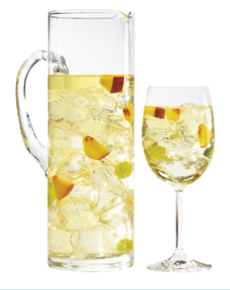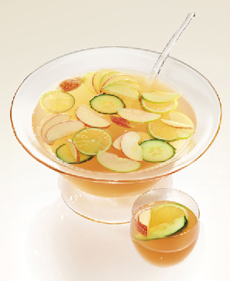TIP OF THE DAY: Summer Sangria Recipe
|
Thanks to our friends Laura and Charles for reviving our interest in sangria, a Spanish fruit punch. At a light summer dinner last week, the sangria they served paired beautifully with every dish.
Americans were first introduced to sangria at the 1964 World’s Fair in New York City. The Spanish Pavilion had three restaurants, and the sangria offered with meals changed the way Americans thought of fruit punch. There are many recipes for red, rosé and white sangria. The types of wine and fruit used in Spain depended on what was grown in the particular region. We have two recipes from Courvoisier that are a bit more elegant than most recipes. The first uses sparkling wine instead of still wine, plus Cognac and peach liqueur, which complements the fresh summer peaches. It’s easier to serve sangria from a pitcher, but if you want to show off your punch bowl, go ahead. A tip about ice: The larger the pieces of ice, the slower they melt (and don’t water down the punch). If you have metal ice cube trays with a removable insert, you can omit the insert and freeze a block of ice in the base. If you happen to have other fruit or mint at hand, feel free to add it to the recipe, in addition to the fruits specified. There is no “best” recipe for sangria. It’s all delicious, and that’s what makes it such an easy drink to concoct (and serve), whether for parties, weekday dinner or weekend lounging. Sangria is not just for summer. With varied ingredients (stronger wines, more liqueur, winter fruits) it’s a year-round drink. Here’s the history of sangria. Ingredients |
|
|
|
Preparation 1. CUT the fruit: Thinly slice the peaches and cut the grapes in half. Add the fruit to a pitcher with the Cognac, peach liqueur and grape juice. 2. CHILL in the refrigerator for for 1-3 hours. Immediately before serving, add the Prosecco and stir gently (you don’t want to break the bubbles). Serve over ice. ____________________ |
||


